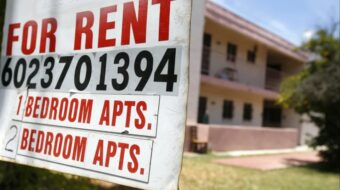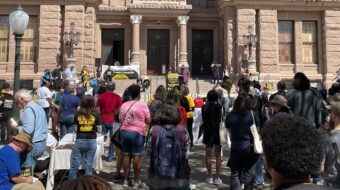If you think Americans living just above the poverty line are making it, then think again.
A startling new study by the Census Bureau reveals that one in three Americans – 100 million people – live in poverty or near poverty.
“These numbers are higher than we anticipated,” Trudi J. Renwick, the bureau’s chief poverty statistician, told the New York Times. “There are more people struggling than the official numbers show.” The Census Bureau, which published the poverty data last month, came up with the analysis of people slightly above the poverty line at the request of the Times.
The data shows that 51 million Americans live on incomes less than 50 percent above the poverty line while 49.1 million are below the poverty line which translates into $24,343 for a family of four.
The official poverty measure, devised a half-century ago, has long been considered ill-conceived in determining a person’s disposable income. So, the Census Bureau developed a new measure of poverty that more accurately reflects disposable income.
It no longer ignores the billions of dollars that Americans pay out in taxes, medical care and work expenses while taking into account government assistance to the needy in food stamps, tax credits and other programs.
The new measure, called the Supplemental Poverty Measure, counts these factors and adjusts for regional differences in the cost of living that the traditional method ignores.
Based on the new measure, of the 51 million “near poor,” more than 50 percent were pushed down from higher income levels: more than eight million by taxes, six million by medical expenses, and four million by work expenses like child care and transportation, according to the Times.
At the same time, nearly 20 percent were lifted up from poverty by government benefits.
Put together, the new Census Bureau poverty measure reveals the actual and potential role of government in lifting Americans out of poverty, all the more so during the current economic crisis made worse by the Republican drive to increase income inequality and dismantle social welfare programs.
In a surprising discovery, the Census Bureau’s analysis revealed that 28 percent of the near poor work full-time, year round.
The disposable income of Phyllis Pendleton, a social worker, and her husband, a janitor – once adjusted to the new Census Bureau poverty measure — is 29 percent above the poverty line, within the range considered near poor.
“Living paycheck to paycheck,” is how Ms. Pendleton described her family’s condition to the Times. “One bad bill will wipe you out.”
In another revelation, using the new measure the percentage of seniors who are either poor or near poor rose from 22 to 34 percent, which is slightly less that the share among children, 39 percent. High medical costs are likely to account for the increase for seniors.
Yet, another startling finding is that only a quarter of the near poor are insured, and of those 42 percent have private insurance.
Belinda Sheppard’s is among those who fits the near poor income profile. Her income disqualifies her for government assistance with health care. Her employer keeps her on part time status, even though she works 40 hours a week, to avoid paying for health insurance. So she does without health coverage hoping for the best.
Sheppard, whose adult children live with her because they cannot find work, told the Times, “I pay my bills with very small wiggle room. Or none.”
“The emotionally charged terms ‘poor’ or ‘near poor’,” Robert Rector, an analyst with the conservative Heritage Foundation, told the Times, “clearly suggest to most people a level of material hardship that doesn’t exist.” Instead, he said he doesn’t have “any objection to this measure if you use the term ‘low income.'”
But, Sheila Zedlewski, a researcher at the non-partisan Urban Institute, considers the terms “poor” and “near poor” appropriate because “there are a lot of ‘low-income’ Americans struggling to make ends meet, and we don’t pay enough attention to them.”
Reflecting the view of most economists who consider the new method an improvement over the old, Zedlewski told the Times, “It’s very consistent with everything we’ve been hearing in the last few years about families’ struggle, earnings not keeping up for the bottom half.”

MOST POPULAR TODAY


Zionist organizations leading campaign to stop ceasefire resolutions in D.C. area

High Court essentially bans demonstrations, freedom of assembly in Deep South

Afghanistan’s socialist years: The promising future killed off by U.S. imperialism

Communist Karol Cariola elected president of Chile’s legislature






Comments